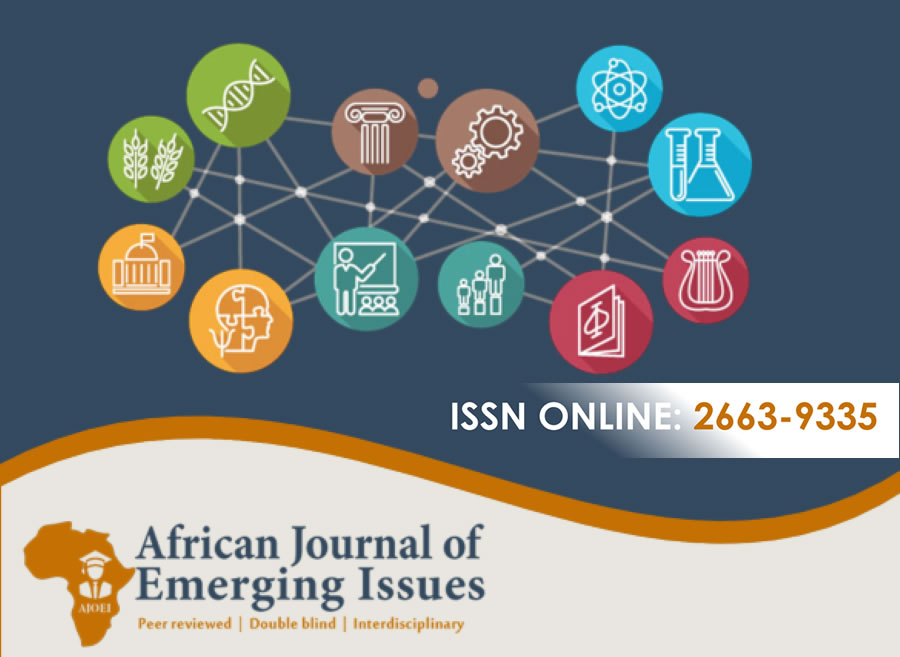THE INTERFACE BETWEEN CLIMATE CHANGE AND FOOD INSECURITY: THE CASE OF KENYA
Abstract
Purpose of the Study: The purpose of the study was to examine the interface between climate change and food insecurity in Kenya, analyzing the mechanisms by which climate change impacts food security, the current state of food insecurity in the country, and the adaptation strategies being employed to address these challenges.
Problem Statement: Food insecurity is a persistent and growing concern in Kenya, with millions of people lacking access to sufficient food for consumption. Kenya’s agricultural sector remains highly vulnerable to climate shocks, with unpredictable rainfall patterns and recurring droughts significantly disrupting crop production and exacerbating food insecurity.
Methodology: The study was a literature-based review, synthesizing findings from various research papers, reports, and data sources. This comprehensive approach facilitated a holistic examination of the complex relationship between climate change and food insecurity in Kenya.
Results of the Study: The study found that climate change has both direct and indirect effects on food security in Kenya. Direct impacts include reduced crop yields due to changes in temperature and precipitation patterns, while indirect effects encompass impacts on household incomes, access to water, and overall health status. The research also underscored the importance of adaptation strategies and indigenous knowledge in mitigating the impacts of climate change on food security. However, it noted that current adaptation efforts may not be sufficient to fully address the escalating challenges posed by climate change.
Conclusion: The study concludes that addressing food insecurity in the face of climate change requires a comprehensive strategy that considers the specific needs and vulnerabilities of different regions in Kenya. It highlights the need for promoting resilient food systems and sustainable development practices to enhance food security in the country.
Recommendations: The study recommends a multifaceted approach to addressing the climate change-food insecurity nexus in Kenya. This includes integrating climate change adaptation strategies into national and local food security policies, strengthening the adaptive capacity of vulnerable communities, enhancing cross-sectoral collaboration, and scaling up investment in both climate change mitigation and adaptation efforts. Furthermore, it emphasizes the need for continued research and monitoring to better understand the evolving dynamics of the climate change-food insecurity interface and to inform evidence-based policymaking.
Keywords: Climate change, food insecurity, Kenya
References
Agesa, B. L., Onyango, C. M., Kathumo, V. M., Onwonga, R. N., & Karuku, G. N. (2019). Climate change effects on crop production in Yatta sub-county: farmer perceptions and adaptation strategies. African Journal of Food, Agriculture, Nutrition and Development, 19(1), 14010-14042. https://doi.org/10.18697/ajfand.84.BLFB1017
Bedasa, Y., & Bedemo, A. (2023). The effect of climate change on food insecurity in the Horn of Africa. GeoJournal, 88(2), 1829-1839. https://doi.org/10.1007/s10708-022-10733-1
Cheruiyot, S. J., Kimanthi, M., Shabani, J. S., Nyamu, N. F., Gathu, C., Agoi, F., & De Meijer, F. (2022). Climate change poses a threat to nutrition and food security in Kilifi County, Kenya. African journal of primary health care & family medicine, 14(1). https://doi.org/10.4102/phcfm.v14i1.3718
Connolly-Boutin, L., & Smit, B. (2016). Climate change, food security, and livelihoods in sub-Saharan Africa. Regional Environmental Change, 16, 385-399. https://doi.org/10.1007/s10113-015-0761-x
Dasgupta, S., & Robinson, E. J. (2022). Attributing changes in food insecurity to a changing climate. Scientific Reports, 12(1), 4709. https://doi.org/10.1038/s41598-022-08696-x
FAO (2023). Severe food insecurity rate doubles in Kenya. Retrieved from https://www.businessdailyafrica.com/bd/economy/severe-food-insecurity-rate-doubles-in-kenya--4405802
Gebre, G. G., Amekawa, Y., & Fikadu, A. A. (2023). Farmers′ use of climate change adaptation strategies and their impacts on food security in Kenya. Climate Risk Management, 40, 100495. https://doi.org/10.1016/j.crm.2023.100495
Hasegawa, T., Fujimori, S., Havlík, P., Valin, H., Bodirsky, B. L., Doelman, J. C., ... & Witzke, P. (2018). Risk of increased food insecurity under stringent global climate change mitigation policy. Nature climate change, 8(8), 699-703. https://doi.org/10.1038/s41558-018-0230-x
Huho, J. M., & Mugalavai, E. M. (2010). The effects of droughts on food security in Kenya. The International Journal of Climate Change: Impacts and Responses, 2(2), 61. https://doi.org/10.18848/1835-7156/CGP/v02i02/37312
Integrated food security Kenya (2024). Kenya: Acute Food Insecurity Situation for February - March 2024 and Projection for April - June 2024 (ASAL). Retrieved from https://www.ipcinfo.org/ipc-country-analysis/details-map/en/c/1156893/#:~:text=In%20the%20current%20period%20
Kabubo-Mariara, J., & Kabara, M. (2018). Climate change and food security in Kenya. In Agricultural Adaptation to Climate Change in Africa (pp. 55-80). Routledge. https://doi.org/10.4324/9781315149776-4
Khisa, G. V., Oteng’i, S. B., & Mikalitsa, S. M. (2014). Effect of climate change on small scale agricultural production and food security in Kitui District, Kenya.
Kogo, B. K., Kumar, L., & Koech, R. (2021). Climate change and variability in Kenya: a review of impacts on agriculture and food security. Environment, development and sustainability, 23(1), 23-43. https://doi.org/10.1007/s10668-020-00589-1
Leonard, L. (2022). Climate change impacts and challenges of combating food insecurity in rural Somkhele, KwaZulu-Natal, South Africa. Sustainability, 14(23), 16023. https://doi.org/10.3390/su142316023
Masipa, T. (2017). The impact of climate change on food security in South Africa: Current realities and challenges ahead. Jàmbá: Journal of Disaster Risk Studies, 9(1), 1-7. https://doi.org/10.4102/jamba.v9i1.411
Ndalilo, L., Wekesa, C., & Mbuvi, M. T. (2020). Indigenous and local knowledge practices and innovations for enhancing food security under climate change: examples from Mijikenda communities in coastal Kenya. Sustainability Challenges in Sub-Saharan Africa II: Insights from Eastern and Southern Africa, 63-82. https://doi.org/10.1007/978-981-15-5358-5_3
Obwocha, E. B. (2015). Assessment of impacts of climate change and variability on food security in west Pokot County, Kenya. Unpublished master’s Thesis, Kenyatta University, Kenya.
Onyutha, C. (2019). African food insecurity in a changing climate: The roles of science and policy. Food and Energy Security, 8(1), e00160. https://doi.org/10.1002/fes3.160
Statista (2024). Number of people facing food insecurity in Kenya 2021. Retrieved from https://www.statista.com/statistics/1236146/number-of-people-facing-food-insecurity-in-kenya/
Wheeler, T., & Von Braun, J. (2013). Climate change impacts on global food security. Science, 341(6145), 508-513. https://doi.org/10.1126/science.1239402
World Food Programme (2024). Kenya. Retrieved from https://www.wfp.org/countries/kenya





